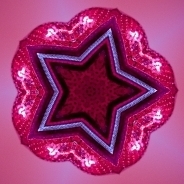Leaderboard
Popular Content
Showing content with the highest reputation on 01/31/2023 in all areas
-
Hey guys, Just thought I'd show you my latest experiments: I've been creating them using the Corona Renderer For C4D feature called Corona Pattern. Corona Pattern will take any little 3D object you create, and use it as the "building block" or "seed" for a larger 3D object you've created. It's kinda like creating a "single stitch" which will be compounded to form a "whole cloth". As I understand it, Corona Pattern is a form of "Scatter" which will take your little 3D object and "scatter" it across a larger object in an organized way. Thus you can create sophisticated "cloth fabrics" which have highly detailed "stitches" forming it. The results you get are more sophisticated and realistic than anything you could do using Displacement, Opacity, Bump and Normal maps, for instance, because the individual "stitches" or "building blocks" are not illusory or dependent upon greyscale maps... they're real 3D geometry with assignable materials, which will exist in light and shadow like any 3D object. But the process does not use up a lot of CPU or memory, and your renders develop as fast as any other kind of render. The effect is not seen in your modeling viewport, but is seen only upon render (with Corona Render, of course). I have been experimenting with it in order to create fascinating "woven and knitted cloths", "pailletted cloth" and "chainmail" type renders. I'd think it would look killer when used as a tweedy/nubbly textile surface for a sofa or chair in an Interior Archviz. But it occurs to me that there might be many more situations in which this effect could be used... to create the facades of buildings, perhaps, or surfaces of sci-fi objects. Thoughts? ras3 points
-
Really well done. Every time I see chainmail, I think of that poor guy at Weta working on LOTR who had to make all that chain mail for every character by cutting plastic plumbing tubes (the ones reinforced by a spiral loop of wire) into individual rings and then linking them into that cloth pattern and gluing the ends together. Kind of makes the work you put into learning Corona Pattern all the more worthwhile doesn't it!!!😀 Again, great work! Just love it. Dave1 point
-
Here I use Corona Pattern to create a tweed style textile to a padded chair:1 point
-
I haven't played with this yet, but your examples look great! Need more hours in the day to experiment and learn. Nice work!1 point
-
Out of all Adobe's programs After Effects feels like one of their most modern imo. But it's really held together by its amazing plugin community. I really wish Adobe would merge After Effects and Animate into one program. They add more new shit to Animate than After Effects, and Animate is a creaky old as shit program held together with gaffer tape. Adobe probably still have me by the gonads. I can't see myself trying this new one.1 point
-
Another big win in my books, straight out the gate, is it runs on Linux. I know Linux fanboys like to crow about how Linux performs so much better, but I am not a Linux fanboy - I don't really like the OS. But I have tried it out with Houdini, and it absolutely flies compared to Windows. It feels like I upgraded my system hardware, when all I have done is reboot into a different OS. Adobe, and Ae specifically, was the one thing that was keeping me from moving my work to Linux entirely, but with Autograph I can potentially finally do that.1 point
-
Wow, that is priced steeply for a 1.0 release. Strange strategy for a challenger. Also, their marketing stuff is really atrocious, their mails and website look like early 90s stuff. I just hope their product quality is exceptional...1 point
-
Like this they will not bite a big chunk out of adobes cacke 😞 the newcomer always needs to be cheaper or at least the same price. like this they cost like the whole creative cloud. This will not fly, unfortunatley.1 point
-
Templates perhaps, but the whole point of wanting a more robust, extendible application is to not have to rely on a slew of 3rd party plugins/scripts, at least for basic work, which has been the bane of Ae forever. An analogy can be drawn with C4D - hugely popular app with a ton of plugins and templates to extend it, but then you have Houdini, and you don't need any of that. Then you factor in the infinite cost of Ae, along with its myriad bugs (in the latest update, H.264 video is a gamble on whether it will actually work in Ae or not, and just show a green screen instead), and things start getting pretty irritating. Regarding the other apps, for compositing and effects, Nuke and Resolve (Fusion) are miles better than After Effects. It's not even a contest. For motion graphics Nuke doesn't enter the conversation. Fusion, while it does have a good foundation for mograph, needs a ton of work to make the UI and UX streamlined enough to actually be able to do any sort of meaningful work without wanting to tear your eyes out. A basic example of this is that you cannot select two nodes of the same type and change the same parameters on them simultaneously. I cannot comment on the other two as I've never used them.1 point
-
Alternative apps don't just compete with AfterEffects but also with it's ecosystem of uncountable plugins, templates, effects, and other kind of add-ons. I thought 2nd in rank alternative was Nuke, 3rd DaVinci Resolve, 4th HitFilm and last Natron. Do we really need one more option ? I'd like to hear some opinions about the alternatives I've mentioned.1 point
-
I have mixed feelings... Mainly because I've made a half decent living teaching AE for the last twenty years : ) But seriously, I really hope Autograph can deliver. Old code can only last so long.1 point
-
I'm cautiously optimistic. I previously put my faith in Cavalry as the potential replacement, but after many years of an inordinate amount of bugs and almost negligible foundational updates (it's still not able to handle even a few high-res images, and its support for video is very poor), it's clear that that's not the one. Autograph looks significantly more robust and capable, straight off the bat, but we'll just have to wait and see. Pricing will play a big role, as will stability.1 point
-
As someone who paid for a yearly subscription five minutes ago, I would also support the idea that everyone should be able to read all the posts. The paywall should only be for commenting, uploading images and tutorials. The quality content should advertise for itself.1 point
-
@Igor My proposal is to keep the paywall but let people see the content of the website for free. Currently everything is behind closed doors, no one can see what exactly we are doing here. Only those who want to comment or post a topic should have to pay a membership. This way we keep unwanted firestarters and trolls away. I don't think there would be someone willing to pay just to have the ability to rant for anything. You will also have a worthy revenue because more people will be willing to pay the small annual subscription just to post their question having seen the quality of help in this site.1 point
-
Also, Maxon is still holding on to OLD way of having a single material open at once in the node editor. It's extremely useful having the node editor be an open editor whereby multiple materials can be opened in the same editor at once if need be. Useful for linking textures across various materials, copy/pasting parameters between materials and working on lookdev for multiple materials for the same object all at once. just some examples.1 point
-
Thats the problem with Octane. If youre happy with its render speed, visual style, and how quickly you can work up materials and lighting, then anything else is going to be a bit of a letdown. Arnold is far more stable and has some more complete and production ready features, but the work done with it is dominated by those using cpu-based farms. Redshift gpu in my experience simply isn't faster to render than Octane. It is better at doing quick cheats like simple fog vs octanes mega slow volume mediums, and faint transparent objects struggle less in RS than Octane, but Redshift completely falls apart on any system with more than 3-4 gpus. 12 gpus in octane is 12 times faster. 12 gpus in redshift... a) it doesnt support 12 gpus, b) of the 8 gpus it does support, it will only be 4 times faster So its fine on a workstation, but rendering anything serious with it gets quite annoying because you end up needing multiple weak nodes instead of having a small number of powerful machines.1 point




